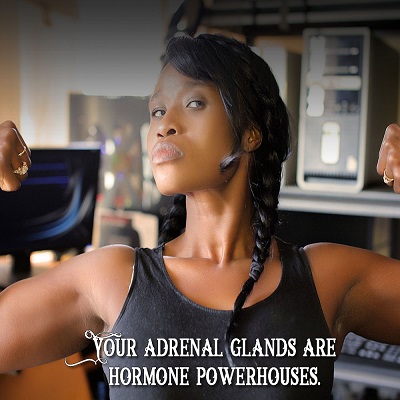 The body has a network of different glands, called the endocrine system, that produces hormones essential for good health and well-being. Let’s take a look at our adrenal glands, which produce a variety of hormones.
The body has a network of different glands, called the endocrine system, that produces hormones essential for good health and well-being. Let’s take a look at our adrenal glands, which produce a variety of hormones.
Atop your kidneys are two small triangular-shaped glands. These are your adrenal glands. There are two parts to the adrenal glands, the outside layer, which is the cortex and the inside part, which is the medulla. Each part plays its role in producing different hormones which are essential for various body functions.
They help to keep certain processes working harmoniously and in balance, such as your metabolism, blood sugar levels, and blood pressure levels. They also help keep salt and water balanced in the body and aid in sexual development. Adrenal hormones also help you respond to stress and keep sex hormones balanced.
Adrenal glands are important for the body’s effective use of carbs and fats, distribution of stored fats, and promotion of healthy gastrointestinal functions.
Hormones Produced from the Adrenal Glands
Adrenaline and Noradrenaline
Also called epinephrine and norepinephrine, these are the main hormones that the adrenal glands’ medulla produces. They’re essential for the body’s fight or flight response, making the heart rate faster and increasing the blood flow to the brain and muscles.
Cortisol
Cortisol is produced in the adrenal cortex, which also aids the adrenaline in the stress response and gives you the energy to handle emergency situations. This hormone also helps regulate your sleep and wake cycle and blood pressure. It’s essential in the immune response, suppressing unregulated inflammation.
Aldosterone
Aldosterone is also produced in the cortex, and it’s important in regulating electrolytes in the body. This hormone is what signals the kidneys to absorb more sodium and release potassium in the urine.
DHEA and Androgenic Steroids
Also secreted in the adrenal cortex, DHEA and androgenic steroids are hormones that become estrogen and androgens in the ovaries and testes. The adrenal glands only produce them in a small amount, and the majority of these sex hormones are produced in the ovaries and testes.
Adrenal Glands and Imbalances
Adrenal glands hormones can become imbalanced due to a number of factors. Some of these are problems originating from the pituitary gland, tumors (benign and cancerous) in adrenal glands, infections, and genetic mutations. Autoimmune diseases, traumatic brain injuries, and compromised immune system due to HIV or AIDS can also lead to adrenal insufficiency.
You know that you may have problems with your adrenals when you experience clusters of the following symptoms:
- Fatigue
- Loss of appetite
- Unexplained weight gain or loss
- Diarrhea
- Nausea
- Sweating
- Vomiting
- Low blood sugar
- Hypotension
- Joint pain
- Muscle pain
- Irregular menstrual periods
- Bruised skin.
Adrenal Gland Disorders
Now, let’s take a look at some of the disorders of the adrenal glands.
Cushing’s Syndrome
This is a rare disorder that develops due to an excessive amount of cortisol in the body. A tumor in the pituitary gland or elsewhere in the body can trigger the adrenal glands to produce too much cortisol. It can also be caused by the prolonged use of steroids.
Overactive Adrenal Glands
This problem occurs when nodules develop in the adrenal glands, causing too much production of certain hormones. Some nodules can be malignant and need to be removed through surgery.
Addison’s Disease
It’s also known as primary adrenal insufficiency and the opposite of Cushing’s syndrome. It occurs when there’s not enough cortisol or aldosterone produced, which can result in your immune system attacking your adrenal tissues.
Adrenal Cancer
This happens when malignant tumors develop in the adrenal glands, producing an excess of at least one hormone. The cancerous tumor can grow a few inches and spread to other organs and tissues.
Congenital Adrenal Hyperplasia
This is an inherited hormonal disorder that refers to the low production of cortisol or aldosterone due to a missing essential enzyme needed to secrete them.
Hyperaldosteronism
This pertains to the excessive production of aldosterone, which can elevate blood pressure. It can also lead to a decline in potassium in the blood, making you feel weak.
Pheochromocytoma
This refers to a tumor in the adrenal medulla, causing a burst of overproduction of epinephrine and norepinephrine. As a result, you have persistent high blood pressure, anxiety, headaches, and sweating.
If you experience any symptoms mentioned above and suspect that you may have an adrenal glands disorder, visit your doctor. You’ll have to undergo some tests for a proper diagnosis, such as urine tests, blood tests, MRI scans, CT scans, and X-rays.
Depending on the disorder, you may be treated with hormonal therapy to keep the hormones balanced. You may undergo surgery to remove tumors, plus radiation and chemotherapy for cancers.
Adrenal glands produce essential hormones for good health. Proper and early diagnosis will help you to manage the symptoms and keep the hormones balanced. Don’t hesitate to seek professional help!






